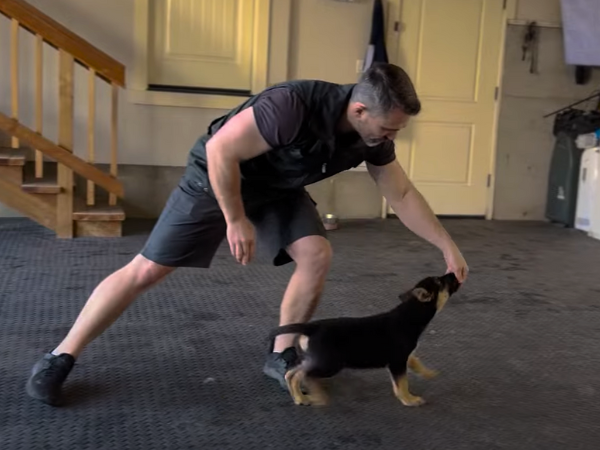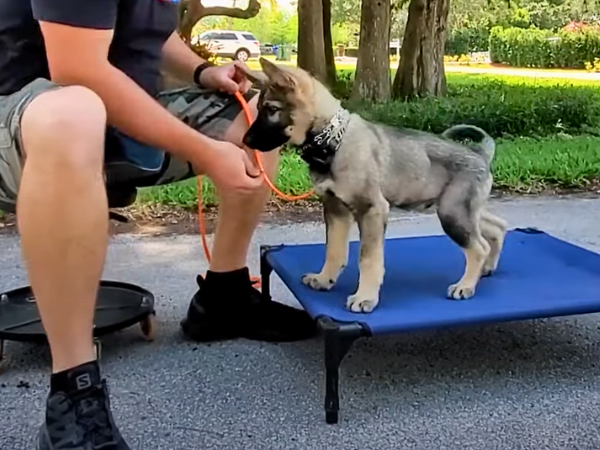By taking the right approach at the right age, you’ll help your dog grow into a well-rounded companion and reliable protector.
Early training often focuses on building a solid foundation with socialization, obedience, and confidence before introducing protection-specific skills.
Understanding Protection Training
Protection training teaches a dog to deter a threat. It is not about making a dog aggressive all the time. The goal is bite inhibition and controlled aggression. This means the dog learns when it is okay to protect and when to hold back.
Key points of protection training include:
- Obedience: The dog must follow commands quickly and without hesitation.
- Controlled response: The dog reacts only when there is a real threat.
- Strong bond: The dog trusts and respects its owner deeply.
- Safety: The dog learns to protect without causing unnecessary harm.
The focus is obedience and a strong bond with the owner. This makes the dog a true protector, not just a threat. Training should start at the right age and with clear goals to avoid problems later.
The Ideal Age To Begin
Begin with basic obedience around 4-6 months. This period is perfect for teaching your dog simple commands like sit, stay, come, and heel. These skills build trust and communication between you and your dog. It also helps your dog learn to focus and respond to your instructions.
During this stage, focus on:
- Socializing your dog with people and other animals.
- Introducing leash walking and house manners.
- Rewarding good behavior consistently.
Formal protection work starts later, between 1-2 years. At this stage, your dog is more physically and mentally mature. This maturity is important because protection training can be intense. Some dogs may be ready earlier or later depending on their breed and personality.

The Importance Of Socialization
Early socialization is crucial from 8-16 weeks. This period is when puppies learn most about their environment. During this time, exposing the puppy to diverse people, places, and sounds builds a strong foundation.
- Meet different people: adults, children, and strangers.
- Visit various places: parks, streets, and pet-friendly stores.
- Introduce new sounds: traffic, vacuum cleaners, and other animals.
A well-socialized dog is less likely to be fearful or aggressive. Socialization helps dogs trust new situations and stay calm. It reduces anxiety and builds confidence. Puppies that miss this phase may struggle with fear or behave aggressively later.
| Socialization Stage | What to Introduce | Benefits |
|---|---|---|
| 8-12 weeks | People, sounds, gentle handling | Builds comfort and trust |
| 12-16 weeks | Other dogs, new environments | Encourages calm and social behavior |
| 16+ weeks | More complex situations | Strengthens confidence and control |
Start socialization early and keep experiences positive. Use treats and praise to reward calm behavior. Avoid overwhelming the puppy. Gradually introduce new challenges, allowing the puppy to adjust.
Choosing The Right Dog
Look for breeds with natural guarding instincts, such as German Shepherds and Rottweilers. These breeds have a strong drive to protect their family and territory. Their physical strength and intelligence make them ideal candidates for protection training.
- Look for calm and alert behavior in puppies or adult dogs.
- Test reactions to new people and environments.
- Observe how the dog responds to loud noises or sudden movements.
Choose a dog that is confident, stable, and eager to please. A confident dog will handle stressful situations calmly. Stability means the dog reacts well to commands and does not panic easily.

The Role Of The Handler
A handler must be calm, consistent, and confident. These qualities help the dog feel secure and ready to learn. Dogs sense emotions. If you are nervous or unsure, your dog will be confused.
Key responsibilities of a handler include:
- Setting clear rules and boundaries.
- Maintaining a calm and steady tone of voice.
- Using consistent commands and signals.
You need to be in full control of your dog at all times during protection training. Control means understanding your dog’s body language, energy levels, and limits. Your dog should view you as the leader and protector.
Finding A Professional Trainer
Protection training is complex and can be risky without proper knowledge. A professional trainer understands how to teach skills step-by-step and how to keep training safe for both you and your dog.
Look for trainers who use positive reinforcement. Positive methods build trust and encourage your dog to learn happily. Avoid trainers who rely on fear or harsh punishment, as these can cause aggression and anxiety.
- Ask for references and success stories from past clients.
- Observe a training session before committing.
- Ensure the trainer is patient and communicates clearly.
A good trainer will evaluate your dog’s temperament first. Not every dog is suited for protection training. The trainer will check if your dog is confident, calm, and focused enough. This evaluation helps create a training plan that fits your dog’s needs.
Safety And Ethics
Protection training is not a one-time event. It’s a lifetime commitment to continued training and control. Owners must keep practicing commands and socializing their dog to prevent aggressive or unpredictable behavior.
Key points of this commitment include:
- Ongoing training: Regular sessions keep the dog’s skills sharp and behavior controlled.
- Clear boundaries: The dog must know when to protect and when to relax.
- Proper socialization: Helps the dog stay calm around strangers and different environments.
- Owner responsibility: Always supervising and controlling the dog to avoid accidents.
Only committed owners should start protection training. This training shapes the dog’s behavior for life. Mistakes can cause harm to people or the dog. Respect, patience, and control are the foundation of safe and ethical protection training.

